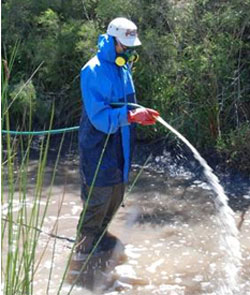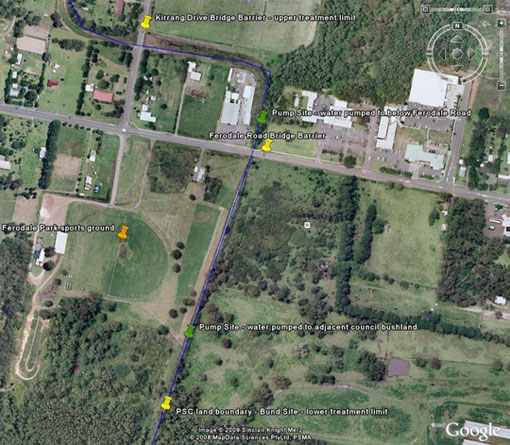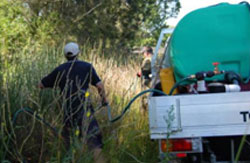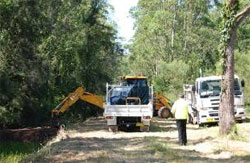 NSW DPI officers drove the vehicle alongside the drain while the spray operator dosed the drain. At the conclusion of the rotenone treatment the drain levels remained lowered. The following day, the drain was dosed with potassium permanganate to ensure the rotenone was neutralised (using the same spray equipment). NSW DPI staff involved in the operation wore appropriate personal protective equipment during mixing and application of rotenone and potassium permanganate. On the two days following treatment NSW DPI staff collected dead pest fish from the drain and disposed of them by burial on site.
NSW DPI officers drove the vehicle alongside the drain while the spray operator dosed the drain. At the conclusion of the rotenone treatment the drain levels remained lowered. The following day, the drain was dosed with potassium permanganate to ensure the rotenone was neutralised (using the same spray equipment). NSW DPI staff involved in the operation wore appropriate personal protective equipment during mixing and application of rotenone and potassium permanganate. On the two days following treatment NSW DPI staff collected dead pest fish from the drain and disposed of them by burial on site.
Results
Large numbers of Eastern gambusia and small numbers of platyfish were observed during the rotenone treatment on 20 January 2009 and several hundred dead Eastern gambusia as well as 90 platyfish were removed the following day and buried. No native fish were observed floating in the drain or on the bank following treatment. Eastern gambusia were observed swimming in the last 30 metres of the treated section on the two days following rotenone treatment and neutralisation. Live yabbies and water beetles were observed throughout the entire treated section of the drain on days following treatment.
NSW DPI staff have since conducted follow up surveys of the area to assess the success of the eradication attempt. These surveys were conducted in March 2009, and July 2009.
The March 2009 survey results found juvenile and adult platyfish in both sections of the drain. The results were inconclusive however as to whether the eradication attempt was unsuccessful, or whether the drain had been restocked from another source of the fish.
A second survey was conducted in July 2009, to assess whether platyfish were present in dams on private land adjacent to the drain, as this could be a potential source of the pest fish. Fortunately, all landholders of the target properties gave permission for fish surveys to be undertaken on their property. Five ponds were surveyed (by electrofishing) and platyfish were discovered in one large dam (in small numbers).
Discussion
As with all pest fish, once the population is widely distributed, it is difficult, if not impossible to eradicate them. Unfortunately, as the eradication was not successful, and surveys have shown that the fish are widely distributed throughout the drain, and in at least one private dam, the eradication of the platy is no longer considered viable.
With any pest fish eradication attempt there is always a chance that they may re-occur. This could be through the release of unwanted pet platyfish from a home aquarium, flooding resulting in release from outdoor ponds, or that the eradication attempt was unsuccessful.
Acknowledgements
Port Stephens Council donated considerable in-kind support to the eradication attempt including several staff, machinery, equipment and signage with an approximate value of $10,000. Their expertise and assistance were greatly appreciated and ensured the attempt was conducted with minimal difficulties.
NSW DPI research staff conducted fish surveys to establish the scope of the platyfish population and to assess the number of native species.


